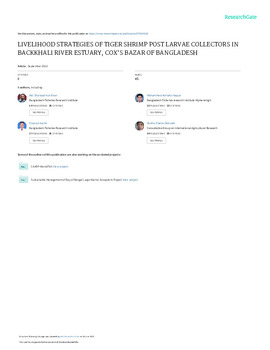Livelihood strategies of tiger shrimp post larvae collectors in backkhali river estuary, cox’s bazar of Bangladesh

Citation
Hasan, M. et al. (2012). Livelihood strategies of tiger shrimp post larvae collectors in backkhali river estuary, cox’s bazar of Bangladesh. International Journal of Sustainable Agricultural Technology, 8(9): 1-7
This study aim was to understand the livelihoods of tiger shrimp (Penaeus monodon, Fabricius, 1798) post larvae collectors in the Backkhali river estuary areas under Cox’s Bazar district in Bangladesh during November 2010 to April 2011 where shrimp fry are caught. There are about 130-140 families and about 1000 people are living in the adjacent area. Most of the fry collectors have no land or house. They build house on Government (khas) land near the coast, the housing is mainly with earthen/bamboo or polythen. It was found that per month income of 30% of fry collector 5000-6000 taka and 48.3% have no toilet. Also it was found that 43.3% respondents had 2 meals per day only. The main occupations of this community are shrimp post larvae collecting, small treading, day labor, hilsha fishing, fishing labor, fish drying, salt production and farming.
Permalink
Date Available
Type
Publisher
Countries
Topics
Language